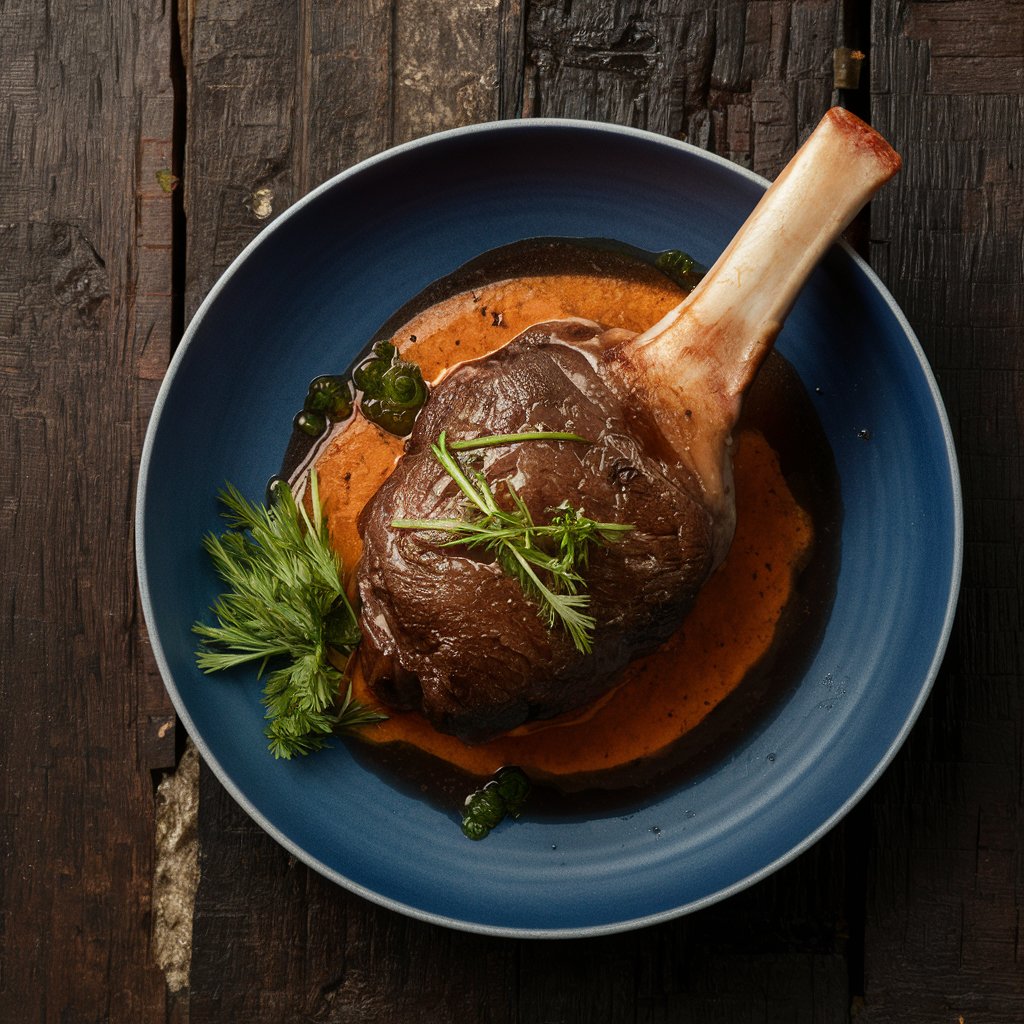Exploring Beef Shank
What is Beef Shank?
Beef shank, also known as shank, comprises a flavorful cut of meat obtained from the lower leg of the cow. This portion of the animal boasts rich connective tissue, which tenderizes during the cooking process.
Understanding the Anatomy
The shank consists of muscles, tendons, and bone, all contributing to its unique texture and flavor profile. Due to its location on the animal, beef shank is often considered a tougher cut, requiring slow cooking methods to achieve optimal tenderness.
Culinary Uses
Beef shank proves versatile, finding application in various culinary endeavors. From hearty stews to aromatic braises, this cut imbues dishes with depth and richness. Popular cuisines such as Italian, Asian, and Latin American frequently showcase beef shank in their traditional recipes.
Cooking Techniques
To unlock the full potential of beef shank, one must employ proper cooking techniques. Braising, stewing, and slow-cooking methods prove ideal for breaking down tough fibers and infusing the meat with flavorful aromatics.
Nutritional Value
Beef shank serves as a good source of protein, iron, and B vitamins. However, it boasts higher fat content compared to leaner cuts of beef. Moderation remains key when incorporating beef shank into a balanced diet.
Delving into Osso Buco
What is Osso Buco?
Osso buco, a traditional Italian dish, features a flavorful cut of meat from the veal or beef shank. The term “osso buco” translates to “bone with a hole,” referring to the marrow-filled bone that enhances the dish’s richness.
Origins and Culinary Significance
Hailing from Milan, Italy, osso buco holds a prominent place in Italian cuisine. It is often associated with celebrations and special occasions, showcasing the culinary prowess of Italian chefs.
Traditional Preparation Methods
Osso buco is typically prepared by braising the shank slices in a flavorful broth or sauce until tender. Classic ingredients include tomatoes, onions, carrots, and aromatic herbs, such as rosemary and thyme.
Regional Variations
While the traditional osso buco recipe remains steadfast, regional variations abound throughout Italy and beyond. Each locale adds its unique twist, incorporating local ingredients and culinary traditions.
Culinary Pairings
Osso buco pairs exceptionally well with creamy polenta, risotto Milanese, or crusty Italian bread to soak up the flavorful sauce. A glass of robust red wine complements the dish’s richness, enhancing the dining experience.

Comparing Beef Shank and Osso Buco
Key Differences in Flavor and Texture
While both beef shank and osso buco originate from the same cut of meat, they exhibit distinct flavor profiles and textures. Beef shank tends to be richer and more robust, with a pronounced beefy flavor, while osso buco offers a delicate, melt-in-your-mouth texture with subtle veal or beef undertones.
Cooking Techniques and Culinary Applications
Beef shank is often utilized in heartier dishes that require long, slow cooking methods to tenderize the meat and develop complex flavors. In contrast, osso buco is celebrated for its elegant presentation and refined flavor, making it a centerpiece of upscale Italian dining.
Nutritional Variances
From a nutritional standpoint, both cuts offer similar profiles, boasting high protein content and essential vitamins and minerals. However, osso buco may contain slightly lower fat content due to its leaner preparation methods.
Cultural and Regional Influences
The preparation and consumption of beef shank and osso buco are steeped in cultural and regional traditions. While beef shank finds its place in hearty dishes from around the world, osso buco remains synonymous with Italian culinary heritage, embodying centuries of gastronomic excellence.
Culinary Applications and Recipes
Exploring Culinary Uses of Beef Shank
Beef shank’s versatility extends beyond traditional stews and braises, making it a sought-after ingredient in various cuisines worldwide. From Asian-inspired soups to Latin American classics, chefs around the globe showcase the rich flavors and tender texture of beef shank in diverse culinary creations.
Incorporating Beef Shank into Home Cooking
Home cooks can experiment with beef shank in a myriad of ways, from slow-cooked curries to hearty chili recipes. With a bit of patience and creativity, beef shank can transform ordinary meals into extraordinary culinary experiences.
Cooking Osso Buco: Tips and Techniques
Osso buco’s elegant presentation and sophisticated flavors make it a favorite among home cooks and professional chefs alike. Mastering the art of osso buco requires attention to detail and proper technique, from selecting the perfect shank slices to mastering the art of braising.
Classic Osso Buco Recipe
For those eager to recreate the flavors of Italy at home, a classic osso buco recipe is a must-have in any culinary repertoire. With simple ingredients and step-by-step instructions, home cooks can elevate their dining experience with this iconic Italian dish.
Nutritional Comparison and Health Considerations
Nutritional Profile of Beef Shank and Osso Buco
When it comes to nutritional content, both beef shank and osso buco offer a rich array of essential nutrients. Packed with protein, iron, and B vitamins, these cuts provide a hearty and satisfying meal option. However, it’s essential to consider factors such as fat content and portion size when incorporating them into a balanced diet.
Health Benefits and Considerations
While beef shank and osso buco offer nutritional benefits, moderation is key, especially for individuals watching their fat intake or managing certain health conditions. By balancing portion sizes and incorporating a variety of nutrient-rich foods, individuals can enjoy the flavors of beef shank and osso buco while supporting their overall health and well-being.
Sustainability and Ethical Considerations
In addition to nutritional considerations, it’s essential to examine the sustainability and ethical implications of consuming beef products. From environmental impact to animal welfare concerns, conscious consumers may choose to explore alternative options or source beef from sustainable and ethical suppliers.
Exploring Culinary Traditions
Global Variations in Beef Shank and Osso Buco
Beef shank and osso buco have transcended cultural boundaries, finding their way into diverse culinary traditions around the world. From the hearty stews of Eastern Europe to the aromatic curries of South Asia, different cultures have put their unique spin on these beloved cuts of meat.
Asian Inspirations
In Asian cuisine, beef shank is often featured in soups and noodle dishes, adding richness and depth to broths and sauces. From Vietnamese pho to Chinese braised beef noodle soup, beef shank plays a central role in these flavorful and comforting dishes.
Latin American Delights
In Latin American cuisine, beef shank shines in hearty stews and slow-cooked dishes, such as Colombian sancocho and Mexican birria. The tender meat absorbs the vibrant flavors of spices and herbs, creating a mouthwatering culinary experience.
Middle Eastern Delicacies
In Middle Eastern cuisine, beef shank is transformed into succulent kebabs and aromatic stews, such as Persian khoresh-e gheymeh and Lebanese shawarma. The meat is marinated in flavorful spices and slowly cooked to perfection, resulting in tender and flavorful dishes.
European Classics
In European cuisine, osso buco is celebrated as a culinary masterpiece, particularly in Italian and French cooking. From the iconic Milanese osso buco to the decadent French pot-au-feu, these dishes showcase the elegance and sophistication of beef shank in European culinary traditions.
Exploring Alternative Cuts
Beyond Beef Shank and Osso Buco
While beef shank and osso buco are undoubtedly flavorful and versatile cuts, there are other lesser-known cuts of meat that offer unique culinary experiences. From oxtail to beef cheeks, exploring alternative cuts allows chefs and home cooks to expand their culinary horizons and discover new flavors and textures.
Oxtail: A Rich and Gelatinous Cut
Oxtail, the tail of cattle, is prized for its rich flavor and gelatinous texture. Often used in soups, stews, and braises, oxtail adds depth and complexity to dishes. Popular in Caribbean, African, and Asian cuisines, oxtail is a favorite among adventurous cooks seeking to explore new culinary frontiers.
Beef Cheeks: Tender and Succulent
Beef cheeks, the muscles located in the jaw area of the animal, are renowned for their tender and succulent texture. Slow-cooked to perfection, beef cheeks melt in the mouth, delivering a burst of flavor with every bite. Whether braised, smoked, or grilled, beef cheeks are a favorite among chefs looking to create memorable dining experiences.
Shank Alternatives: Lamb and Veal
For those seeking alternatives to beef shank, lamb and veal shanks offer similar flavor profiles and culinary possibilities. Lamb shanks, with their rich and gamey taste, are popular in Mediterranean and Middle Eastern cuisines, while veal shanks are prized for their delicate flavor and tender texture, particularly in Italian cooking.
Exploring New Horizons
By exploring alternative cuts of meat, chefs and home cooks can unleash their creativity in the kitchen and create dishes that are as delicious as they are unique. Whether experimenting with oxtail in a spicy Jamaican stew or braising beef cheeks in a rich red wine sauce, the possibilities are endless.
The Art of Pairing and Presentation
Elevating Your Dining Experience
Pairing beef shank and osso buco with the right accompaniments can enhance the overall dining experience, elevating the flavors and textures of the dish. From side dishes to garnishes, thoughtful pairing and presentation can take your meal from ordinary to extraordinary.
Perfect Pairings: Side Dishes and Garnishes
Consider pairing beef shank with creamy mashed potatoes, roasted root vegetables, or a fresh green salad to balance out the richness of the meat. For osso buco, opt for creamy polenta, sautéed greens, or a tangy gremolata to complement the flavors of the dish.
Serving Suggestions: Plating and Presentation
When it comes to plating, pay attention to presentation and aesthetics. Arrange beef shank or osso buco on a bed of polenta or mashed potatoes, garnished with fresh herbs and a drizzle of sauce for an elegant touch. Use decorative plates and utensils to enhance the dining experience further.
Enhancing the Experience: Wine and Beverage Pairings
While we avoid mentioning alcoholic beverages, pairing beef shank and osso buco with the right non-alcoholic beverages can enhance the dining experience. Consider serving sparkling water with a splash of citrus or a refreshing herbal tea to cleanse the palate between bites.
Creating Memorable Moments
By paying attention to pairing and presentation, you can create memorable dining experiences that delight the senses and leave a lasting impression on your guests. Whether hosting a dinner party or enjoying a cozy meal at home, thoughtful consideration of flavors and textures can elevate the dining experience.

Frequently Asked Questions (FAQs)
What’s the difference between beef cutter and osso buco?
The primary difference lies in the preparation and presentation. Beef shank refers to the raw cut of meat, while osso buco specifically refers to the dish prepared by braising beef or veal shank slices in a flavorful broth or sauce.
Can beef shank be substituted for osso buco in recipes?
Yes, beef shank can be substituted for osso buco in recipes that call for braising or slow-cooking methods. However, keep in mind that the flavor and texture may vary slightly, so adjustments may be needed to achieve the desired results.
How do you tenderize beef shank and osso buco?
Beef shank and osso buco benefit from slow cooking methods, such as braising or stewing, to tenderize the meat and enhance its flavors. Additionally, marinating the meat beforehand or using acidic ingredients in the cooking process can help break down tough fibers.
Are there any cultural or regional variations in the preparation of these cuts?
Yes, both beef shank and osso buco have regional variations in their preparation methods and seasoning. Different cuisines and cultures may have unique ways of cooking these cuts, incorporating local ingredients and culinary traditions.
What are some common misconceptions about beef shank and osso buco?
One common misconception is that osso buco can only be made with veal shank. While traditional osso buco recipes use veal, beef shank can also be used to create a delicious and flavorful dish with a slightly different taste profile. Additionally, some may mistakenly believe that beef shank is tough and undesirable, but when cooked properly, it can be tender and succulent.


